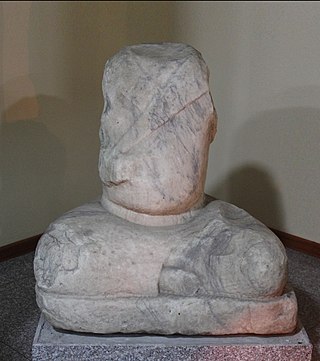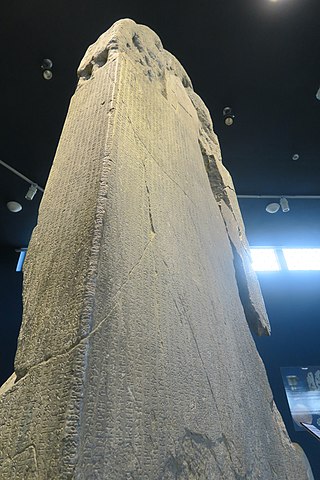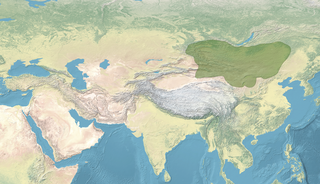Related Research Articles

Bilge Qaghan was the fourth Qaghan of the Second Turkic Khaganate. His accomplishments were described in the Orkhon inscriptions.

The Göktürks, Türks, Celestial Turks or Blue Turks were a nomadic confederation of Turkic peoples in medieval Inner Asia. The Göktürks, under the leadership of Bumin Qaghan and his sons, succeeded the Rouran Khaganate as the main power in the region and established the First Turkic Khaganate, one of several nomadic dynasties that would shape the future geolocation, culture, and dominant beliefs of Turkic peoples.

Kul Tigin was a general and a prince of the Second Turkic Khaganate.

The Old Turkic script was the alphabet used by the Göktürks and other early Turkic khanates from the 8th to 10th centuries to record the Old Turkic language.
Ilterish Qaghan was the founder of the Second Turkic Khaganate.
Old Turkic is the earliest attested form of the Common Turkic languages, found in Göktürk and Uyghur Khaganate inscriptions dating from about the eighth to the 13th century. It is the oldest attested member of the Siberian Turkic branch of Turkic, which is extant in the modern Western Yugur language. It is not the ancestor of the Modern Uyghur language; the contemporaneous ancestor of Modern Uyghur was one of the Middle Turkic languages, later giving rise to Chagatai.

The Toquz Oghuz was a political alliance of nine Turkic Tiele tribes in Inner Asia, during the early Middle Ages. The Toquz Oghuz was consolidated and subordinated within the First Turkic Khaganate (552–743) and remained as a nine-tribe alliance after the Khaganate fragmented.

The Eastern Turkic Khaganate was a Turkic khaganate formed as a result of the internecine wars in the beginning of the 7th century after the First Turkic Khaganate had splintered into two polities – one in the east and the other in the west. Finally, the Eastern Turkic Khaganate was defeated and absorbed by the Tang dynasty, and Xueyantuo occupied the territory of the former Turkic Khaganate.
The Basmyls were a 7th- to 8th-century Turkic nomadic tribe who mostly inhabited the Dzungaria region in the northwest of modern-day China.
Louis Bazin was a French orientalist.
The Greek-language inscriptions and epigraphy are a major source for understanding of the society, language and history of ancient Greece and other Greek-speaking or Greek-controlled areas. Greek inscriptions may occur on stone slabs, pottery ostraca, ornaments, and range from simple names to full texts.
The Tariat inscriptions appear on a stele found near the Hoid Terhyin River in Doloon Mod district, Arkhangai Province, modern-day Mongolia.. The stele was erected by Bayanchur Khan of the Uyghur Khaganate in the middle of the eighth century.

Irk Bitig or Irq Bitig, known as the Book of Omens or Book of Divination in English, is a 9th-century manuscript book on divination that was discovered in the "Library Cave" of the Mogao Caves in Dunhuang, China, by Aurel Stein in 1907, and is now in the collection of the British Library in London, England. The book is written in Old Turkic using the Old Turkic script ; it is the only known complete manuscript text written in the Old Turkic script. It is also an important source for early Turkic mythology.

Qocho or Kara-Khoja, also known as Idiqut, was a Uyghur kingdom created in 843, with strong Chinese Buddhist and Tocharian influences. It was founded by Uyghur refugees fleeing the destruction of the Uyghur Khaganate after being driven out by the Yenisei Kirghiz. They made their summer capital in Qocho and winter capital in Beshbalik. Its population is referred to as the "Xizhou Uyghurs" after the old Tang Chinese name for Gaochang, the Qocho Uyghurs after their capital, the Kucha Uyghurs after another city they controlled, or the Arslan (lion) Uyghurs after their king's title.
Sir-Kıvchak were a Turkic people whose existence is controversial and who were proposed to be precursors to the Kipchaks who settled in East Europe in the 10th century.
The Tatar was one of the seven original Turkic tribes that made up the Kimek confederation, along with the Imur, Yemek, Bayandur, Kipchak, Lanikaz and Ajlad. The Tatār were the third in order. The Kimek tribes originated in the Central Asian steppes, and had migrated to the territory of present-day Kazakhstan. The Tatar, as part of the Kimek, were mentioned by Gardizi.
Orkhon Turkic is the language used in the oldest known written Turkic texts. It is the first stage of Old Turkic, preceding Old Uyghur. It is generally used for the language in which the Orkhon and Yenisei inscriptions are written.
The Ongin inscription was discovered in 1891 in Mongolia near the Ongi River, 160 km south of the Orkhon inscriptions and 402 km south-west of the Tonyukuk inscriptions. It was erected in honor of El Etmish Yabgu. Line 12 makes it clear that the author of the inscription erected a memorial to his father. According to Gerard Clauson, it must have been erected between 716 and 735, during the reign of Bilge Qaghan. According to Ercilasun it was erected in 719 or 720.
El Bilga Khatun or Ilbilga Katun was the wife of the 8th century Göktürk Turkic Qaghan, Ilterish Qaghan, the founder of the Second Turkic Khaganate and the mother of Bilgä Qaghan, the fourth Qaghan of the same Khaganate. She is mentioned in the Orkhon inscriptions erected in honor of Bilgä Qaghan and his brother.

Karabalgasun inscription is a 9th century trilingual inscription located in the Karabalgasun, the historical capital of the first Uyghur Khaganate, in Mongolia. The stele bearing the inscription is believed to be erected during the reign of the eighth Uighur ruler, Baoyi Qaghan. Written in Old Uyghur, Sogdian, and Chinese, the inscription marks the qaghan’s military accomplishments and those of his predecessors, as well as their adoption and support of the Manichean religion. Encyclopædia Iranica describes it as "one of the most important sources for the history of the Uighur Steppe Empire and the study of Manicheism in China and Central Asia", citing many of the historical events recorded in the inscription are only known from it.
References
- ↑ Louis Bazin (1991), Les Calendriers Turcs Anciens et Medievaux, Lille, p. 210-221
- ↑ "TURK BITIG". bitig.kz.
- ↑ Wilhelm Radloff (1987), Die Inschriften am Choito-Tamir, Die Alttürrkischen InschriftenDer Mongolei, p.260-268
- ↑ "TURK BITIG". bitig.kz.